Broiler chicken breeding in households
Alternatives to Broiler Chickens Breeding in Peasant Households
Published: December 22, 2011
By: Stafie Leonard (The Professional Association of Poultry Breeders in Iasi County)
Abstract
At the moment, in Romania, there are three hybrids frequently used in poultry industry: Cobb 500, Ross 308 and Hubbard Flex. Basicly, these hybrids have similar productive characteristics and needs. Hybrid meat Cobb 500 has been designed so as to obtain higher performance with low costs. It is not choosey about nutritional requirements, so in terms of protein, start discussing about the recipe (the percentage of protein in feed prices in general affect the finished feed), the hybrid needs meat are 21% 22.5% PB ( Gross protein), unlike Ross 308, which needs to vary between 22 and 25% PB Hubbard Flex 21 22% PB. For the types of farm we have studied, we followed the rules published in the Directive 2007/43/EC, which sets minimum standards of protection and welfare of chickens for meat production. Shelter used in practice to increase the number of 300 chicks were used two types of housing: a disabled worker´s car and a bed of corn turned into a shelter for birds. According to this study results, a broiler chicken with a weight of 1.9-2.2 kg costs 7.06 lei, the initial investment is not particularly large and amortized by increasing the first series of chickens, which shows economic efficiency of an actual 300 broiler chickens in a household agro- industrial. If we take into account that a broiler chicken at a weight of 1.9 to 2.2 kilograms live can sell at a price about 12 lei/chicken, produces a net income of 4.94 lei/chicken. It results a total value of 1447.42 lei/series in each production cycle. Breeding broiler chicken in small herds will bring additional incomes in household/small farmers and the forages made by the breeders in their own farms are higher capitalized.
Key words: broiler chicken, profitable, household, investment, fodder, hybrid, cost
Key words: broiler chicken, profitable, household, investment, fodder, hybrid, cost
INTRODUCTION
If we consider that the most research studies and debates are directed to big exploitations and producers in poultry industry (both eggs and meat production), who have the financial possibilities to employ specialists and who have a wide variety of poultry tools and equipments, then we may say that the middle and small producers are kind of deprived of accessing high technologies in this field. Lack of money, the economical incapacity to contract long-term credits, as well as the internal instability on our markets, are the main category of reasons which cause the lower investments in these type of farms, no matter of production direction. That´s why I´ve considered extremely necessary to study and to write articles and papers about improving the specific works in poultry farms, about a minimum level of technology, machinery and equipments, presenting in the same time some offers for inputs and biological sources.
Due to the diversity of hybrids for meat that are currently on the market, we have to make an overview of them, in order to give the breeders the right informations and
proper technologies.
proper technologies.
Thus, in addition presentation parameters of technical guidelines, and present some details of practice growth and exploitation of meat chickens. At the moment, in Romania, there are three hybrids frequently used in poultry industry: Cobb 500, Ross 308 and Hubbard Flex. Basicly, these hybrids have similar productive characteristics and needs.
Hybrid meat Cobb 500 has been designed so as to obtain higher performance with low costs. It is not choosey about nutritional requirements, so in terms of protein, start discussing about the recipe (the percentage of protein in feed prices in general affect the finished feed), the hybrid needs meat are 21%-22,5% PB (Gross protein), unlike Ross 308, which needs to vary between 22 and 25% PB Hubbard Flex 21- 22% PB.
Table 1 show the comparative needs of protein and energy metabolized for each of the three hybrids in your question.
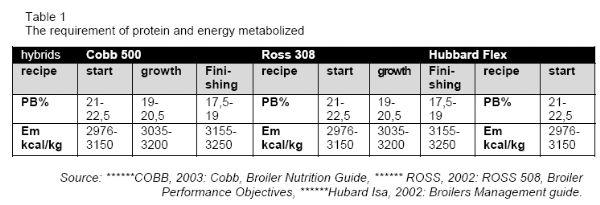
Cobb 500
In terms of microclimate conditions, Cobb 500 is fastidious, requiring special care to maintain the parameters in accordance with the guidelines of operation. Because a high-speed growth, it presents both an increased sensitivity and the fact that increasing the permanent bedding, litter should be maintained in optimal conditions. Presents a high capacity feed intake, so that, in terms of time of light, can be applied programs light with a long dark. As hybrid, Cobb 500 has been created especially for the production of the chest and has a high yield at slaughter. As a major disadvantage of this hybrid of meat, because high speed of growth include the emergence of sudden death syndrome of chickens.
Ross 308
Ross 308 hybrid has been created for the production of the chest and legs are quite shapely. Requires a more expensive feed to gain performance, but presents a better resistance to the microclimate. Is found widely in our Romania due that parents of hybrids Ross meat had a higher percentage of parents lay against the Cobb 500 and the fact that the hatching percentage is higher.
Hubbard Flex
Hubbard meat Hybrid Flex is a hybrid that is well adapted to conditions of food and microclimate empirical but not to expect great performance if you are not providing the necessary point of view of technology. In comparison, Cobb 500 requires exacting management technology with a prescription cheap fodder, Ross 308 requires a well balanced feed, and more expensive but in terms of management do not pose special problems. Hubbard Flex is a hybrid that does not raise any claim in terms of management and technology in terms of feeding.
In Table 2 we compared body weights of each hybrid and feed consumption for a kg of live meat. 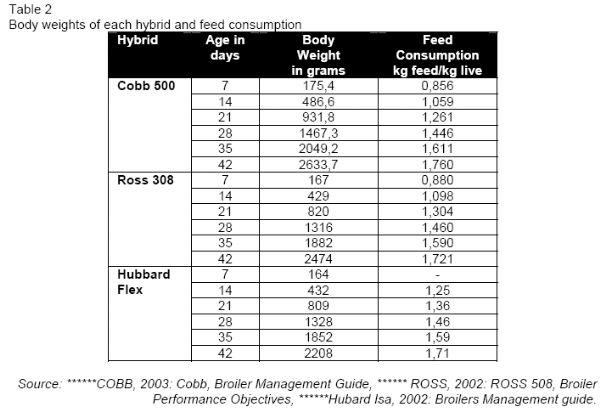

MATERIAL AND METHOD
This study was held in several householdings in Iasi county, in different villages, under financial limitations, but where the peasants were intending to improve and make more profitable the existing broiler chickens´ breeding system.
The three broiler types presented in "Introduction" chapter were the biological material offered to the owners. I explained them the meat production advantages and financial capitalization for each type of broiler chicken. In the end, the farmer''''´s option for one of the three hybrids was the result of his own wish, relayed on the existing conditions in that household but also a scientific choise, considering the documentation I´ve presented.
The researched was relied on some minimum but essential measures:
- actual birds specialized on a specific production (broilers in our case);
- minimum number of 300 head;
- compliance with a minimum of technical operating and maintenance;
- compliance with minimum health requirements.
- minimum number of 300 head;
- compliance with a minimum of technical operating and maintenance;
- compliance with minimum health requirements.
For the types of farm we have studied, we followed the rules published in the Directive 2007/43/EC, which sets minimum standards of protection and welfare of chickens for meat production.
By analytic method of efficiency calculating and based on the zootehnic patterns in this study, I analysed the available materials in every household, observing, identifing and adjusting them to breeding systems that I determined and I sdecided to be the best solution for that medium or small farm. All the steps I made together with these breeders/peasants were relied on the existing rules and reglementations for broilers rising and wellness.
The results and economic values for efficiency were determined by some formulas and efficiency index from specialized scientific papers.
RESULTS AND DISCUSSIONS
The shelter
Shelter used in practice to increase the number of 300 chicks were used two types of housing: a disabled worker''''´s car and a bed of corn turned into a shelter for birds. Wagon used not require large investment, it was necessary to achieve the just and the location of electrical sources of light, system of feed and drinking. Bed maize required more investment for the walls, ceiling and insulation plus equipment. For walls and ceiling was wood, and as insulating the building were used textile waste, bevatex.

• The temperature was provided by two flow controlled radiators, used for heating homes, with a power of 1800 w/h/radiator. Maintain the required temperature was achieved by two thermostats products company Siemens.
• Ventilation tunnel type, ie, forced evacuation and admission free. For evacuation were used two fans use type endeavor.
• Lighting was provided by two fluorescent light sources with a low 20 W/h/lamp. The program of light was done with a digital timer time.
Feeding and watering system
• Feeding system
For feeding as the operating principle and constructive type of wholesome we used in Figures 1, 2. In terms of manufacturing such system of feed is relatively simple and does not require too large an investment. These can be wooden or galvanized sheet, just respecting the principles of operation. A nutritious type it provides a front for feeding chicken to 37.5 for age over 21 days, so for a number of 300 head will be used 8 nutritious. As advantage, using this model does not involve the use of nutritious during starting, 1 7 days, other types of nutritious.
A disadvantage to be clear is reduced handling time of depopulation in the production hall. You must specify that these schemes are not specified the height adjustment depending on the age of chicks. This factor remains to be explored and developed by each producer in terms of material available. We can only point out that it may fix an adjustable suspension system, it may have achieved that supports individual adjustable height. In terms of loss of feed, with this model are minimum losses. system of feed above will apply a cap to protect the feed from the inside. By the storage bunker to store system of feed 37 chickens for a period of approximately 1 3 days.
• Watering system
Watering system must ensure a clean water and discretion, to be distributed uniformly in the shelter, to provide front drinking under age and production class. Model constructive watering system presents to us is very simple. Principle of operation is shown in Figure 3, the water comes from the main water pipe in a tank bursting pressure with a float to maintain a constant level in the basin. Before the pool can put a filter for retaining the natural impurities in water. From the pool leaving a conduit provided with a valve closure, the horse pond. System drinking is provided with a floater to ensure a constant level of water in the horse pond. System drinking will make sheets ofgalvanized for corrosion protection against water and chemical agents in the existing shelter. The dimensions listed below provides the front 150 for feeding birds will therefore use two watering.
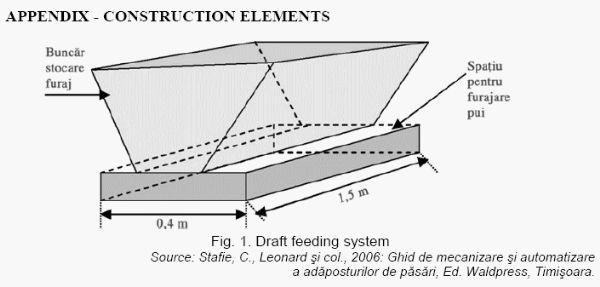
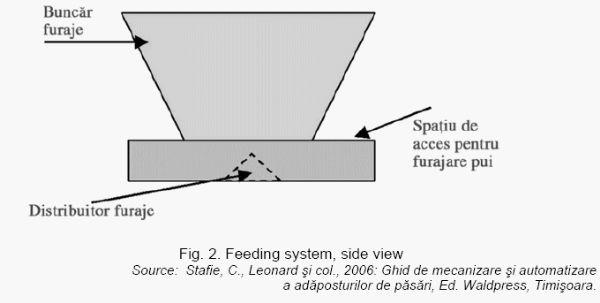

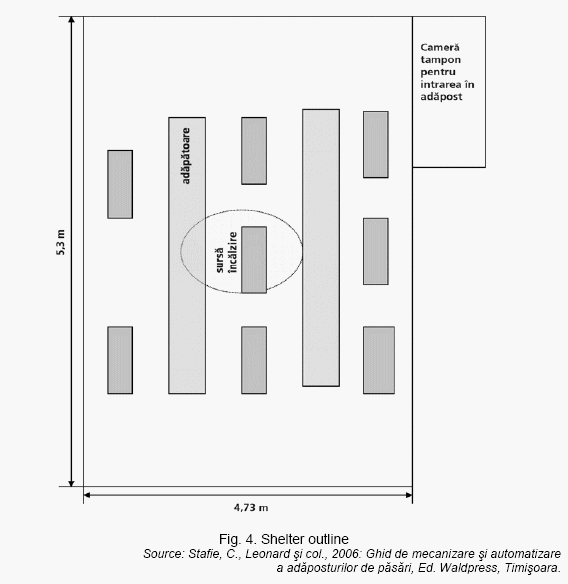
Fodder consumption
Consumption of feed and feed consumption body weight obtained in a herd of 300 chicken meat in hybrid FF Hubbard Flex application in technology presented so far.
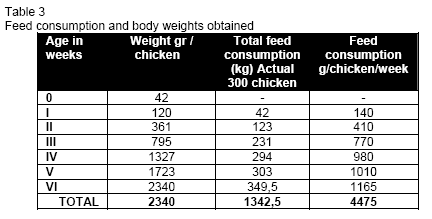
Economic calculations
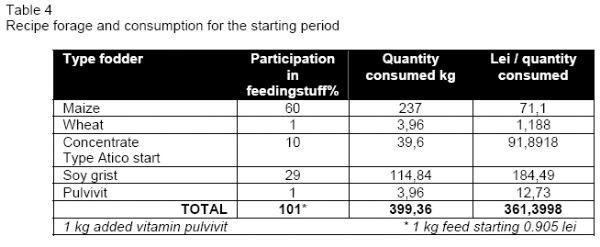
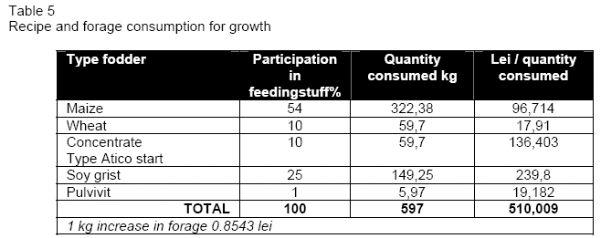
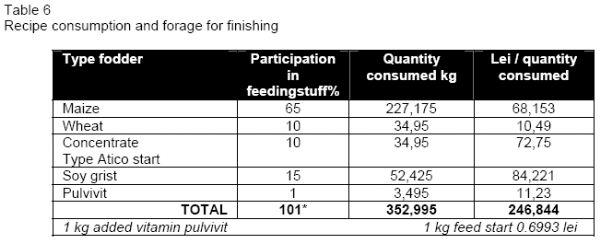
Prices for feed ingredients:
1. Atico start focusing type 2.3205 lei/kg
2. Atico type growth focused 2.2848 lei/kg
3. Atico concentrated type finishing 2.0813 lei/kg
4. grain maize 0.3 lei/kg
5. wheat 0.3 lei/kg
6. 1.6065 soy grist flower lei/kg
7. pulvivit 3.2130 lei/kg

CONCLUSIONS
From the data presented above shows that a chicken meat with a weight of 1.9 2.2 kg costs 7.06 lei / Chicken, the initial investment is not particularly large and amortized by increasing the first series of chicken, which shows economic efficiency of an actual 300 chicken meat in a household agro- industrial. If we take into account that a chicken meat at a weight of 1.9 to 2.2 kilograms live can sell at a price about 12 lei / chicken produces a net income of 4.94 lei / so put a total value 1447.42 lei / effectively in a production cycle of 9 weeks from 6 weeks to 3 weeks production and veterinary vacuum. Raising broiler chickens in small herds can bring additional income household, and a critical value are higher forage resources obtained by them (eg maize).
REFERENCES
Books
[1] Decun, Mihai, 2006: Amplasarea judicioasă a feremelor zootehnice, Referat Revista Ferma.
[1] Decun, Mihai, 2006: Amplasarea judicioasă a feremelor zootehnice, Referat Revista Ferma.
[2] Duţă, Gheorghe şi col., 1976: Instalaţii de ventilare şi climatizare, Ed. Didactică şi Pedagogică, Bucureşti.
[3] Huţu, Ioan şi col. 2006: Creşterea puilor pentru Carne, ediţia a III-a revăzută şi adăugită, Ed. Mirton, Timişoara.
[4] Popescu Băran, Mircea şi col. 1966: Creşterea industrială a păsărilor.
[5] Stafie, C., Leonard şi col., 2005: Ghid de Creştere a Puilor de Carne, Ed. Waldpress, Timişoara.
[6] Stafie, C., Leonard şi col., 2006: Ghid de mecanizare şi automatizare a adăposturilor de păsări, Ed. Waldpress, Timişoara.
[7] Ştefanescu, Gheorghe si col., 1999: Creşterea păsărilor în fermele mici şi mijlocii, Ed. Ceres, Bucureşti.
[8] Vacaru-Opriş, Ioan şi col., 2002: Tratat de Avicultură, vol. II. Ed. Ceres, Bucureşti.
[9] Vacaru-Opriş, Ioan şi col., 2004: Tratat de Avicultură, vol. III. Ed. Ceres, Bucureşti.
[10] Vacaru-Opriş, Ioan şi col., 2005: Sisteme şi Tehnologii de Creştere a Puilor de Carne, Ed. Ceres, Bucureşti.
[11] ***Asociaţia Oamenilor de Afaceri Iaşi, 2006: Implementarea acquisului comunitar în avicultură.
[12] *** Big Dutchman, 2005,2004: Echipamente avicole.
[13] *** COBB, 2003: Cobb, Broiler Nutrition Guide.
[14] *** COBB, 2004: Cobb, Broiler Management Guide.
[15] *** Naukra, 2006: Hale producţie.
[16] *** Nutreco Company, 2002: Hybro PN, Tehnical information PN Broilers.
[17] *** ROSS, 2002: ROSS PM3, Broiler Performance Objectives.
[18] *** ROSS, 2002: ROSS 508, Broiler Performance Objectives.
[19] *** ROSS, 2002: ROSS Broiler Management Manual.
[20] *** Roxell, 2005: Innovative System four Poultry.
[21] *** Hubard Isa, 2002: Broilers Management guide.
[22] *** Hubbard Isa, 2005-Management guide Parent Stock.
Related topics:
Authors:
Recommend
Comment
Share
4 de enero de 2012
Thanks for the comments. The study started from the need to find an optimal solution for the small household, in the context in which small farmers have no specific information but no money.
Recommend
Reply
31 de diciembre de 2011
An interesting study about alternatives to Broiler Chickens Breeding in Peasant Households
Recommend
Reply
Islamabad Group
28 de diciembre de 2011
It is a comprehensive article about alternatives to Broiler Chickens Breeding in Peasant Households. Ii provides good information for Nutritionist as well as breeder manager that how to control and manage their flocks and gain maximum benefits.
Recommend
Reply

Would you like to discuss another topic? Create a new post to engage with experts in the community.











.jpg&w=3840&q=75)